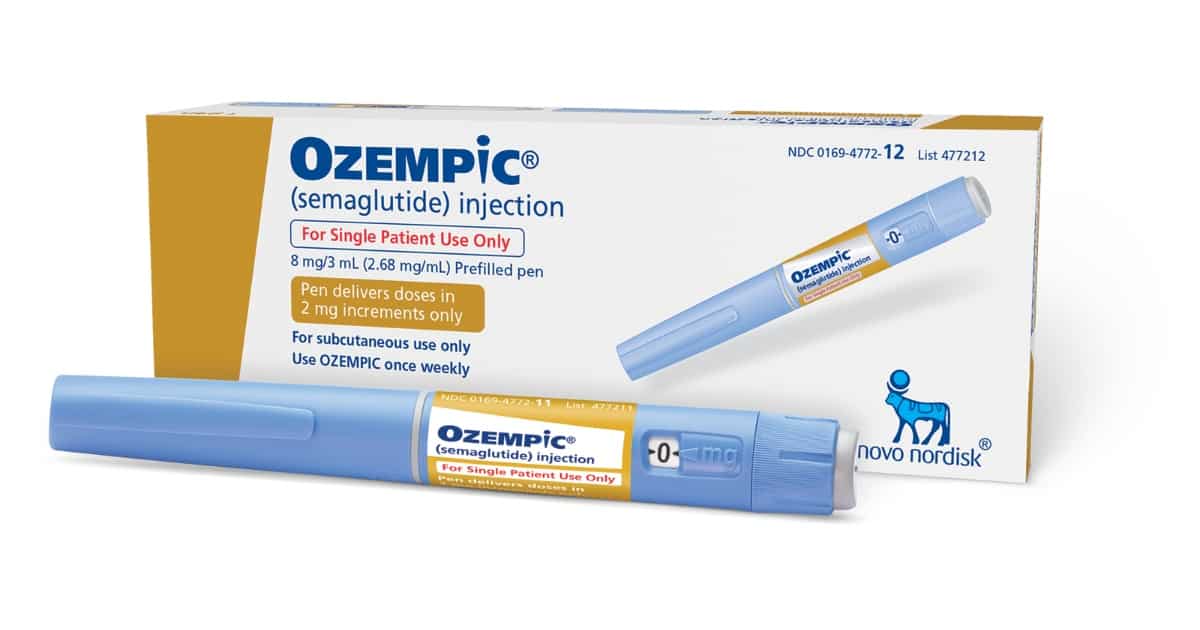Your Ozempic dosage depends on your health history, health goals, lifestyle, and reason for taking the medication.
Figuring out how much Ozempic to take can take time, and it should always be a decision made jointly with your doctor.

Key Facts
- Ozempic typically starts at a dose of 0.25 milligrams (mg) weekly for the first 4 weeks to minimize side effects.
- Depending on individual effectiveness and tolerance, the dose may be increased to 0.5 mg weekly after the initial period, and further to 1 mg or 2 mg if needed.
- Each dosage requires a new prescription for a different dosing pen.
- Higher doses of Ozempic can lead to more pronounced side effects. Dose changes should only be made under the guidance of a healthcare provider.
- While not FDA-approved for weight loss, Ozempic can help with weight management when combined with lifestyle changes.
Table of Contents
- What dose do you typically start with?
- What is a normal Ozempic dose?
- How and when can you increase your dose?
- What is the right dose for me?
- What is the maximum dose of Ozempic for weight loss?
- What happens if I stop taking Ozempic?
- Are there different Ozempic pens?
- What is the strongest Ozempic?
- What do I do if I forget to take my dose?
- What is the maximum weekly dose?
What dose do you typically start with?
If you’re new to Ozempic, or semaglutide in general, your doctor will want to start you on a low dose.
This is because Ozempic may cause adverse side effects including nausea, vomiting, diarrhea, constipation, low blood sugar, and suppressed appetite, which can be difficult and debilitating.
To minimize the likelihood of side effects, starting at a lower dose is the best way to make sure that your body is getting used to the medication without overwhelming your system.
According to the manufacturer, a typical starting dose is 0.25 milligrams (mg) once per week for the first 4 weeks.
If you are seeing improvements in blood sugar levels and insulin resistance without negative side effects, your doctor may increase your dose after the first 4 weeks.
Learn more about administering the medicine in: Ozempic Injection: Where and How to Inject.
“My doctor wasn’t too keen on prescribing it at first, but agreed we should try it for insulin resistance and gave me a 3-month prescription to start. That was 15 months ago.”
Stevie Cook, T1D (read about Stevie’s experience with Ozempic)
What is a normal Ozempic dose?
While there isn’t a “one-size-fits-all” dose of Ozempic, dosages are tailored to individual needs and responses. The dosing typically progresses as follows:
- Initial treatment: Start with 0.25 mg once weekly for the first 4 weeks. This lower initial dose helps to minimize potential side effects.
- Ongoing treatment: If well-tolerated, increase to 0.5 mg once weekly starting from week 5.
- Dose adjustments: If blood sugar management remains insufficient at 0.5 mg, consult your doctor about potentially increasing the dose.
This structured approach ensures that each person receives a customized treatment plan based on their specific health outcomes and tolerance to the medication.
How and when can you increase your dose?
Initially, you should remain on the starting dose for at least 4 weeks to allow your body to adjust to the medication.
Starting at week 5, if well-tolerated, your doctor may recommend doubling your dose to 0.5 mg, which you should maintain for another 4 weeks. During this period, it’s important to monitor your blood sugar levels and watch for any adverse effects.
If your blood sugar management has not improved on 0.5 mg, and you are tolerating the medication well, your doctor might suggest further increasing your dose. An increase in dosage will mean a new prescription since higher doses require a larger Ozempic dosing pen.
Depending on your response, you may be advised to increase to 1 mg or 2 mg once weekly.
What is the right dose for me?
Determining the appropriate dose of Ozempic is a decision that should be made jointly with your doctor. Your specific dose will depend on various factors, including your health history, goals, lifestyle, height, weight, level of insulin resistance, diet, and daily activity.
Generally, higher doses may result in better outcomes such as lower blood sugar levels, weight loss, and improved A1c readings.
However, increasing the dose also raises the likelihood of experiencing side effects like nausea, vomiting, diarrhea, and low blood sugar, particularly as your body adjusts to the medication.
Always consult your doctor when considering dose adjustments to ensure safety and effectiveness.
Read more in: Ozempic Side Effects: What You Need to Know.
What is the maximum dose of Ozempic for weight loss?
First and foremost, it’s important to understand that Ozempic is not FDA-approved as a weight-loss medication. Although research indicates that Ozempic can help facilitate weight loss, there is no designated dose for this purpose because it is not approved for weight management.
Combining Ozempic with a healthy diet and regular exercise may enhance its effectiveness in managing weight.
See more in: Can Ozempic Help You Lose Weight?
If you are taking Ozempic off-label (not approved by the FDA) for weight management, your healthcare provider will guide you on the proper dose to take for your situation.
If weight loss is a primary concern, consider discussing other FDA-approved weight-loss medications with your doctor.
For instance, Wegovy, a related drug also based on semaglutide, is approved specifically for weight loss. The standard dosage for Wegovy is 2.4 mg weekly, which might be an effective option under a doctor-approved care plan.
Learn more in: Ozempic vs. Wegovy: Which Drug is Right for You?
Zepbound, a tirzepatide-based medication approved in 2023 for weight loss, offers similar benefits and might be considered in your treatment plan.
What happens if I stop taking Ozempic?
Do not stop taking any diabetes medications without consulting your healthcare provider. Stopping Ozempic may lead to regaining the weight you’ve lost and could result in elevated blood sugar levels and increased insulin resistance.
On average, people who discontinue Ozempic regain about two-thirds of the weight they had previously lost in about a year.
If you experience severe side effects, find that Ozempic does not suit your lifestyle, or face issues with insurance coverage, it’s important to discuss these challenges with your doctor. There may be alternative treatments that can be a good replacement.
Are there different Ozempic pens?
Ozempic is available in various dosing pens to simplify the dosing process. The options include:
- Red pen (0.25-mg and 0.5-mg doses): This pen contains a total of 2 mg of Ozempic. It can deliver either 8 doses at 0.25 mg each or 4 doses at 0.5 mg each. The duration it lasts will depend on the dose used: up to 2 months for the 0.25-mg dose and about 1 month for the 0.5-mg dose.
- Blue pen (1-mg dose): This pen contains a total of 4 mg of Ozempic, equating to 4 doses at 1 mg each, designed to last approximately 1 month.
- Yellow pen (2-mg dose): This pen contains a total of 8 mg of Ozempic and delivers 4 doses at 2 mg each, lasting about 1 month.
Note that if you need to increase your dose from 0.5 mg to 1 mg, or from 1 mg to 2 mg, you will require a new prescription for the appropriate dosing pen.
What is the strongest Ozempic?
All Ozempic pens contain the same active ingredient, semaglutide. There is no stronger formulation in larger pens; rather, they simply provide a larger quantity of the same drug.
When a person increases their dose of Ozempic, they are increasing the amount of medication taken each week, not the concentration of the drug itself.
What do I do if I forget to take my dose?
If you miss a dose of Ozempic, try to take it as soon as you remember, but only within 5 days of the missed dose. If more than 5 days have passed, skip the missed dose and continue with your regular dosing schedule.
Do not worry — missing a single dose is unlikely to significantly impact your blood sugar control or insulin resistance.
What is the maximum weekly dose?
The maximum dose of Ozempic is 2 mg, administered once weekly on the same day and at the same time. It can be taken with or without food.
See more in: Foods to Avoid While Taking Ozempic.
You may change the day of the week you take your dose, provided that your last dose was taken at least 2 days prior.
Never exceed the dose prescribed by your doctor. Overdosing on Ozempic can lead to severe side effects, including nausea, vomiting, and dangerously low blood sugar, which can be life-threatening — especially if you are also taking insulin.
Watch for signs and symptoms of extremely low blood sugar, such as:
- Dizziness
- Confusion
- Increased heart rate
- Shallow breathing
- Shakiness
- Grogginess
- Fatigue
- Unconsciousness
Seek emergency medical attention immediately if you suspect that you’ve overdosed on Ozempic.
Did you find this article helpful? Click Yes or No below to let us know!






Theresa L Kaiser
my daughter did not get the approval for the Ozempic and as a result was off of it for 7 weeks.
she was on the 2mg dose.
is it safe to restart at this dose??!!
PLEASE Advise soonest!
Thank you.
Terri K
Christel Oerum, MS
Unfortunately, that’s not something we can advise on. That is something you have to discuss with her doctor